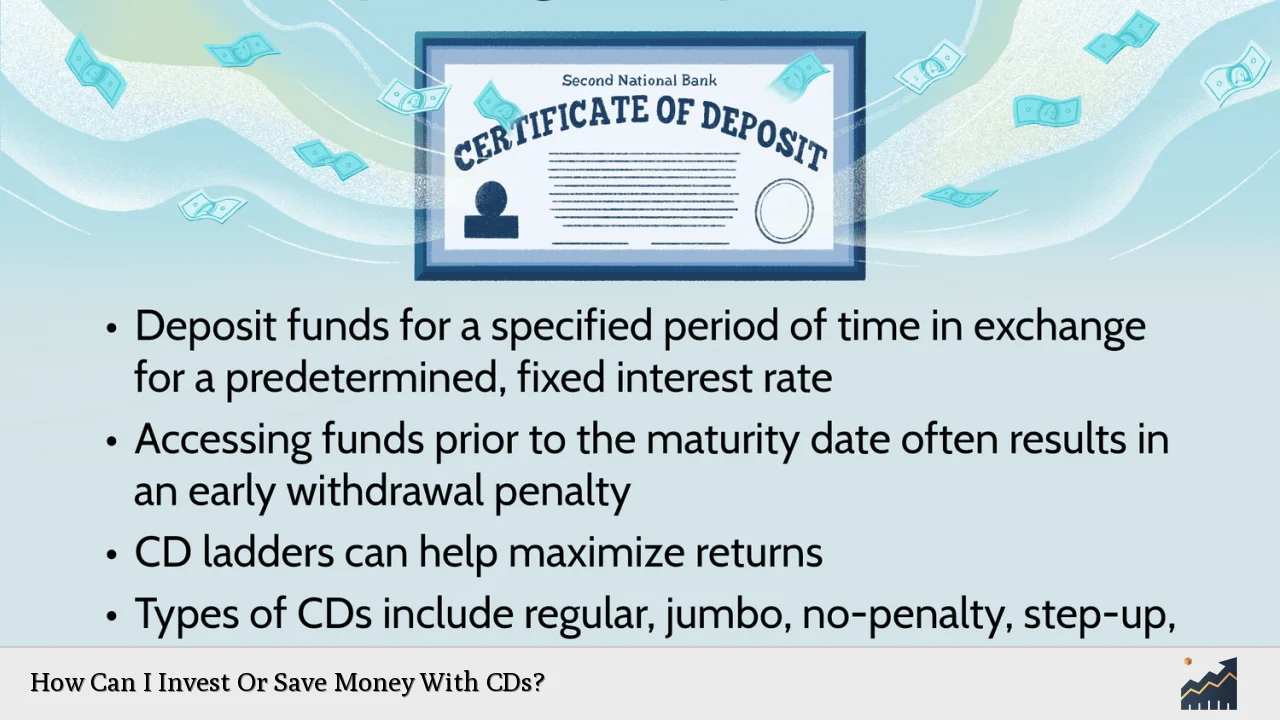Certificates of Deposit (CDs) are a popular savings tool that allow individuals to invest their money for a fixed period in exchange for a higher interest rate than traditional savings accounts. They are considered low-risk investments, making them an attractive option for those looking to grow their savings without exposing themselves to market volatility. When you invest in a CD, you agree to leave your money untouched for a specified term, which can range from a few months to several years. In return, the bank pays you interest on your deposit.
One of the key benefits of CDs is their predictable returns. Unlike stocks or mutual funds, where returns can fluctuate significantly, CDs offer fixed interest rates that provide certainty about how much you will earn by the end of the term. Additionally, most CDs are insured by the Federal Deposit Insurance Corporation (FDIC) up to $250,000, which adds an extra layer of security for your investment.
Investing in CDs can be a strategic move for achieving specific financial goals, such as saving for a down payment on a house or funding education. However, it is essential to understand how they work and the various strategies available to maximize your returns.
| Feature | Description |
|---|---|
| Fixed Terms | CDs have terms ranging from a few months to several years. |
| Higher Interest Rates | CDs typically offer better rates than regular savings accounts. |
Understanding Certificates of Deposit
A Certificate of Deposit (CD) is essentially a time deposit account offered by banks and credit unions. When you open a CD, you deposit a specific amount of money for a predetermined period. During this time, the bank pays you interest at a fixed rate, which is usually higher than that of standard savings accounts. At the end of the term, known as the maturity date, you receive your initial deposit plus any accrued interest.
The interest on CDs can be compounded monthly, quarterly, or annually, depending on the bank’s policy. It’s crucial to read the terms and conditions carefully before investing in a CD because early withdrawal penalties can apply if you need access to your funds before the maturity date.
Some important characteristics of CDs include:
- Interest Rates: Rates vary based on the term length and current market conditions.
- Maturity Dates: You can choose from various terms depending on when you need access to your funds.
- Minimum Deposits: Most banks require a minimum deposit to open a CD, typically ranging from $500 to $2,500.
Understanding these features will help you make informed decisions about which CDs align with your financial goals.
Benefits of Investing in CDs
Investing in CDs has several advantages that make them appealing for both short-term and long-term savings strategies:
- Safety: CDs are one of the safest investment options available since they are insured by the FDIC up to $250,000.
- Predictable Returns: With fixed interest rates, you know exactly how much you will earn by the end of the term.
- Higher Interest Rates: CDs often yield higher returns compared to regular savings accounts due to their fixed nature.
- No Market Risk: Unlike stocks or mutual funds, your investment in a CD is not subject to market fluctuations.
These benefits make CDs an excellent choice for conservative investors looking for reliable income without taking significant risks.
Strategies for Investing in CDs
To make the most out of your investment in CDs, consider implementing one or more strategies that suit your financial goals:
CD Laddering
CD laddering involves dividing your investment across multiple CDs with staggered maturity dates. This strategy allows you to take advantage of higher interest rates while maintaining access to some of your funds at regular intervals. For example:
- $2,000 in a 1-year CD
- $2,000 in a 2-year CD
- $2,000 in a 3-year CD
As each CD matures, you can reinvest the principal plus interest into another long-term CD or use it as needed. This approach provides both liquidity and potential growth.
CD Barbell Strategy
The CD barbell strategy splits your investment between short-term and long-term CDs without using mid-range terms. For instance:
- $5,000 in a 6-month CD
- $5,000 in a 5-year CD
When the short-term CD matures, assess current rates and decide whether to reinvest in another short-term or move into another long-term CD. This strategy offers flexibility while still capturing potentially higher yields.
Bullet Strategy
With the bullet strategy, all CDs mature around the same time. This approach is beneficial if you have a specific financial goal in mind—like buying a house or funding education—by a certain date. For example:
- $10,000 in a 5-year CD
- $5,000 in a 4-year CD next year
- $5,000 in a 3-year CD two years later
This method allows for targeted planning while potentially benefiting from higher rates over time.
Choosing the Right CD
Selecting the right CD requires careful consideration of several factors:
- Interest Rates: Compare rates from different banks and credit unions.
- Terms: Choose terms that align with when you’ll need access to your funds.
- Fees and Penalties: Understand any fees associated with early withdrawals or account maintenance.
By evaluating these elements thoroughly, you can find CDs that best fit your financial situation and goals.
Risks Associated with CDs
While CDs are generally safe investments, they do come with certain risks:
- Inflation Risk: If inflation rises faster than your interest rate, the purchasing power of your returns may diminish over time.
- Liquidity Risk: Your money is tied up until maturity; early withdrawals often incur penalties that can reduce overall earnings.
- Opportunity Cost: Committing funds to long-term CDs may prevent you from taking advantage of better investment opportunities that arise during that period.
Being aware of these risks will help you make informed decisions and manage expectations regarding your investments.
FAQs About Investing Or Saving Money With CDs
- What is a Certificate of Deposit?
A Certificate of Deposit (CD) is a savings account with a fixed term and interest rate. - How do I earn interest on my CD?
You earn interest based on the agreed-upon rate during the term until maturity. - Can I withdraw money from my CD before it matures?
You can withdraw early but may incur penalties that affect your earnings. - What happens when my CD matures?
You receive your principal plus any earned interest; you may also have options to reinvest. - Are all CDs insured?
Most CDs issued by federally insured banks are covered up to $250,000 by the FDIC.
By understanding how to invest or save money with CDs effectively and strategically planning your investments based on personal goals and risk tolerance levels, you can maximize returns while ensuring safety and stability for your finances.

